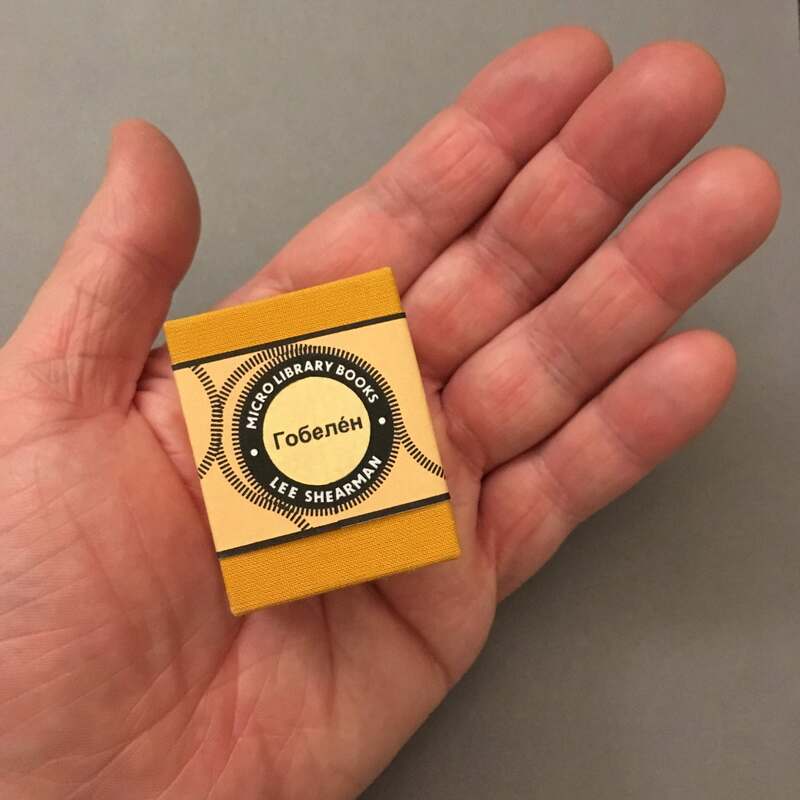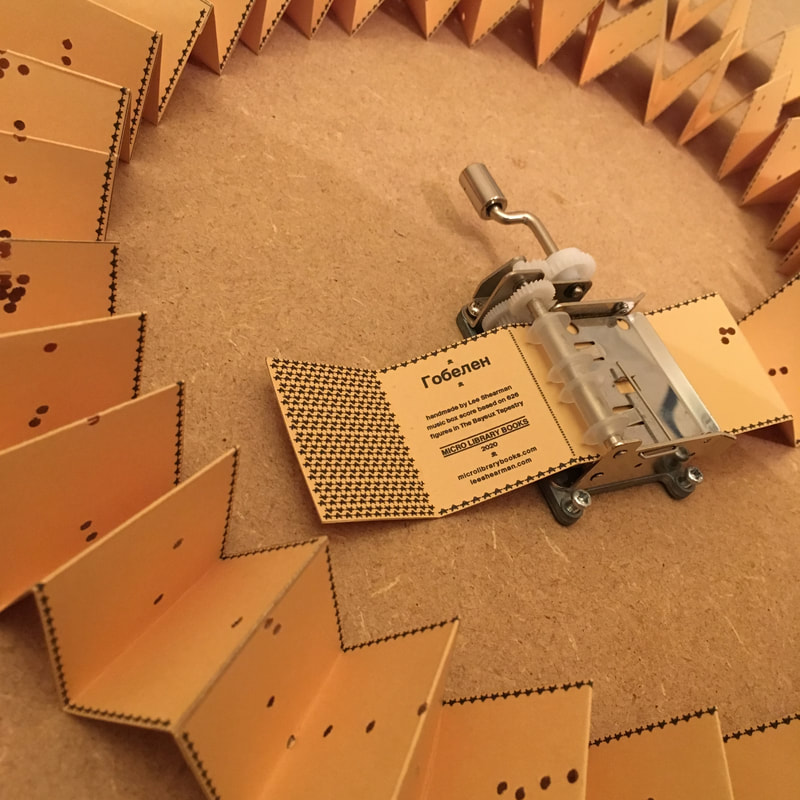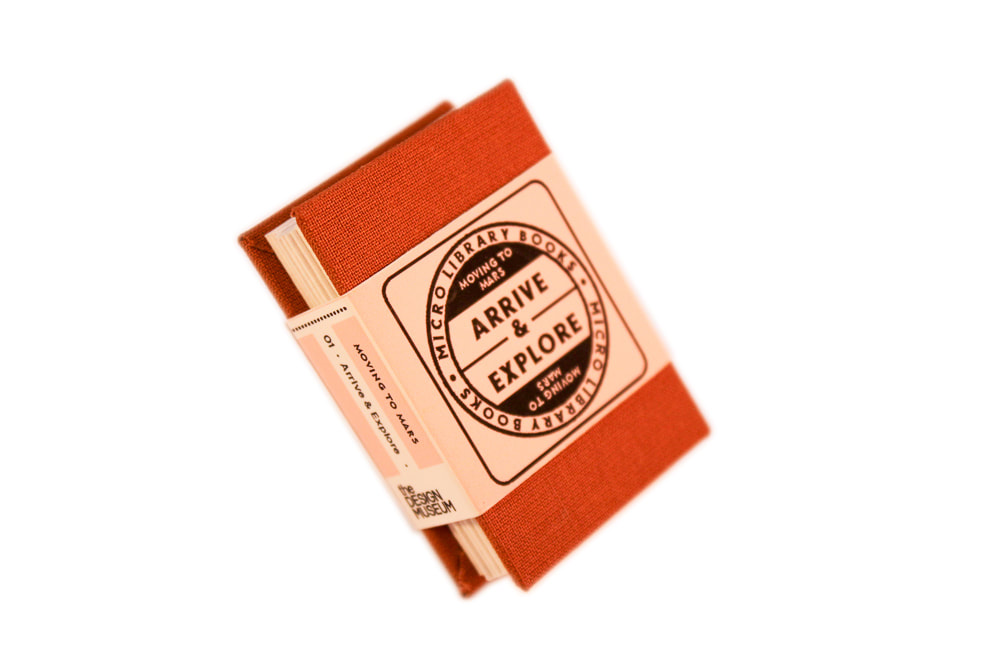TAPESTRY (гобелен): Miniature Concertina-folded artists' book
|
Tapestry by Lee Shearman 35 x 45mm limited edition artists book. Consisting of 13 foot long hole-punched paper strip, accordion-folded into a 120-page book, and wrapped in a printed paper band. When the pages are removed from the covers they can be wound through a 15-note mechanical music box, sounding notes. Handstamped and numbered, Hastings (2020) First exhibited in Love and Music M.E. Slatykov Schedrin Museum Kirov, Russia (2020) |
Making of 'Tapestry' гобелен (5 mins)
For my artists' book I wanted to explore the The Bayeux Tapestry - and experiment with how specific elements of it could inform the content. I began by sketching out ideas and using a scale colour reproduction of The Bayeux Tapestry as reference listed all the visual elements that appear -such as human figures, animals, trees, buildings and ships.
The original Bayeux Tapestry is a 70 metre long embroidery made during the 11th Century, and it depicts the events leading up to the Norman conquest of England, and The Battle of Hastings. It is complex and layered and I was interested in isolating specific areas, to experiment using simple shapes to abstract the visual elements of the tapestry.
Using tracing paper over the printed reproduction I marked every instance on the tapestry where there was a human figure. In total there are 626 human figures scattered across three horizontal zones of the tapestry, and I thought the spacing and position of the heads would translate well into sound and rhythm, offering a wide range of musical notes. To transform the visuals into sound, I decided to create an bookwork that could be played through a 15 note mechanical music box, which also meant that I could use my favoured book-making format — the miniature concertina. To begin, I scanned in the 1/7th scale colour reproduction of The Bayeux Tapestry, and using Adobe Indesign resized it to fit across a template consisting of four A4 sheets.
I marked out with dots the exact position of all 626 heads. It was these dots that once punched out as holes would sound as musical notes when wound through the mechanical music box. I printed the template onto 4 A4 sheets of 180gsm card choosing cantaloupe-coloured card in reference to another type of punch card- the ones used in the Jacquard Loom machine.
After scoring the lap joint, I cropped down each of the A4 sheets and folded each section into eight. I then cut these into individual strips. Using a metal punch tool I perforated three-mm holes into the 15 strips of paper.Once all 626 holes were punched, I glued the strips together to form a single 13.3 foot strip. It was this hole-punched strip that became a musical score. As the paper strip is fed into the music box and passes between the cylinder and comb the holes sound the notes. You can hear a recording of these musical notes in the background of this film.
To make the book covers, I cut a strip backcloth, and marked out spaces for the book board. I glued each piece of book-board to the cloth and cut them out. I then cut off the corners, glued and turning in the edges to form the finished book cover. After gluing a book cover to each end of the 120-page concertina, I wrapped the finished book in a printed band.
For my artists' book I wanted to explore the The Bayeux Tapestry - and experiment with how specific elements of it could inform the content. I began by sketching out ideas and using a scale colour reproduction of The Bayeux Tapestry as reference listed all the visual elements that appear -such as human figures, animals, trees, buildings and ships.
The original Bayeux Tapestry is a 70 metre long embroidery made during the 11th Century, and it depicts the events leading up to the Norman conquest of England, and The Battle of Hastings. It is complex and layered and I was interested in isolating specific areas, to experiment using simple shapes to abstract the visual elements of the tapestry.
Using tracing paper over the printed reproduction I marked every instance on the tapestry where there was a human figure. In total there are 626 human figures scattered across three horizontal zones of the tapestry, and I thought the spacing and position of the heads would translate well into sound and rhythm, offering a wide range of musical notes. To transform the visuals into sound, I decided to create an bookwork that could be played through a 15 note mechanical music box, which also meant that I could use my favoured book-making format — the miniature concertina. To begin, I scanned in the 1/7th scale colour reproduction of The Bayeux Tapestry, and using Adobe Indesign resized it to fit across a template consisting of four A4 sheets.
I marked out with dots the exact position of all 626 heads. It was these dots that once punched out as holes would sound as musical notes when wound through the mechanical music box. I printed the template onto 4 A4 sheets of 180gsm card choosing cantaloupe-coloured card in reference to another type of punch card- the ones used in the Jacquard Loom machine.
After scoring the lap joint, I cropped down each of the A4 sheets and folded each section into eight. I then cut these into individual strips. Using a metal punch tool I perforated three-mm holes into the 15 strips of paper.Once all 626 holes were punched, I glued the strips together to form a single 13.3 foot strip. It was this hole-punched strip that became a musical score. As the paper strip is fed into the music box and passes between the cylinder and comb the holes sound the notes. You can hear a recording of these musical notes in the background of this film.
To make the book covers, I cut a strip backcloth, and marked out spaces for the book board. I glued each piece of book-board to the cloth and cut them out. I then cut off the corners, glued and turning in the edges to form the finished book cover. After gluing a book cover to each end of the 120-page concertina, I wrapped the finished book in a printed band.
MOVING TO MARS SERIES: ARRIVE, SURVIVE & THRIVE
|
|
A series of three handmade miniature books created for the Design Museum's shop to coincide with the Moving to Mars exhibition - an immersive experience exploring the Martian landscape and rethinking the design of daily life.
Featuring new illustration by artist Lee Shearman and poetry by Pip Rowson, each of the three books - Arrive & Explore, Survive & Expand and Thrive & Exploit - focuses on a different stage of a potential relocation to the red planet. Each book is giclee printed on 180 gsm Xativa paper with rayon and card hardbound covers. Dimensions: 35mm x 50mm x 14mm (closed) 35 x 50 x 1088mm (unfurled). Printed by the amazing Martel Colour Print in St. Leonards-on-Sea. |
|
Arrive & Explore
The first in the series, encounters Mars as a sea-less sphere, presenting an imagined map inspired by the artwork of Emmy Ingeborg Brun (1872 - 1929), a Danish socialist and amateur astronomer. |
|
Survive & Expand
The second in the series, puts forward a blueprint of ideas for terraforming, overcoming initial survival challenges and a plan in case of failure. |
|
Thrive & Exploit
The third in the series, presents speculative Martian architecture including buildings imported from Earth and set down on Mars, re-design and re-engineering of our terrestrial way of living, and wholly new creations. |

















